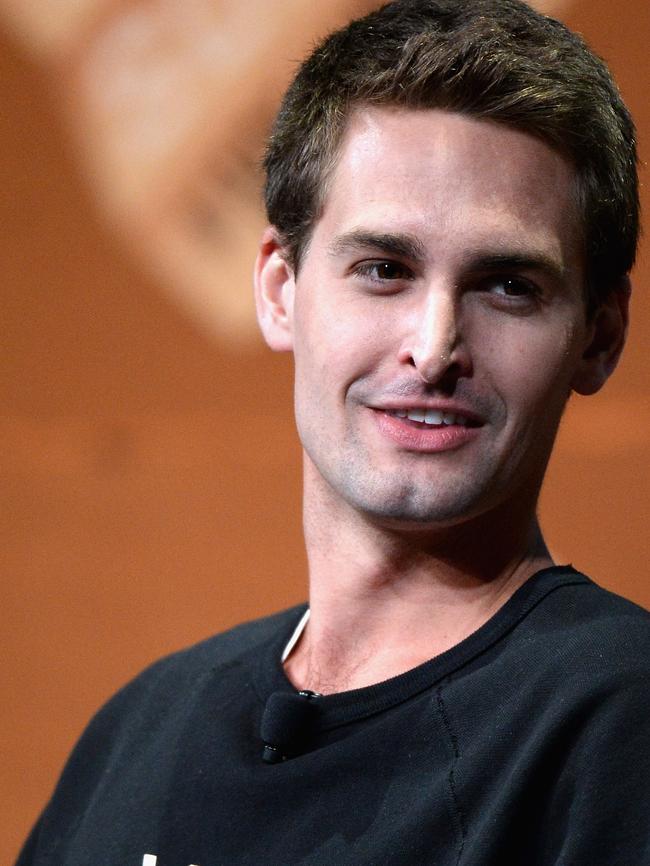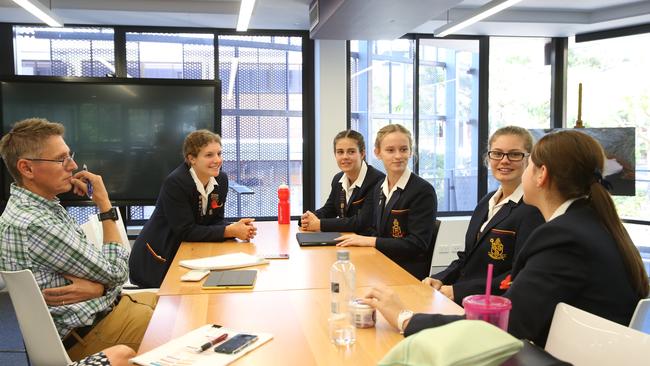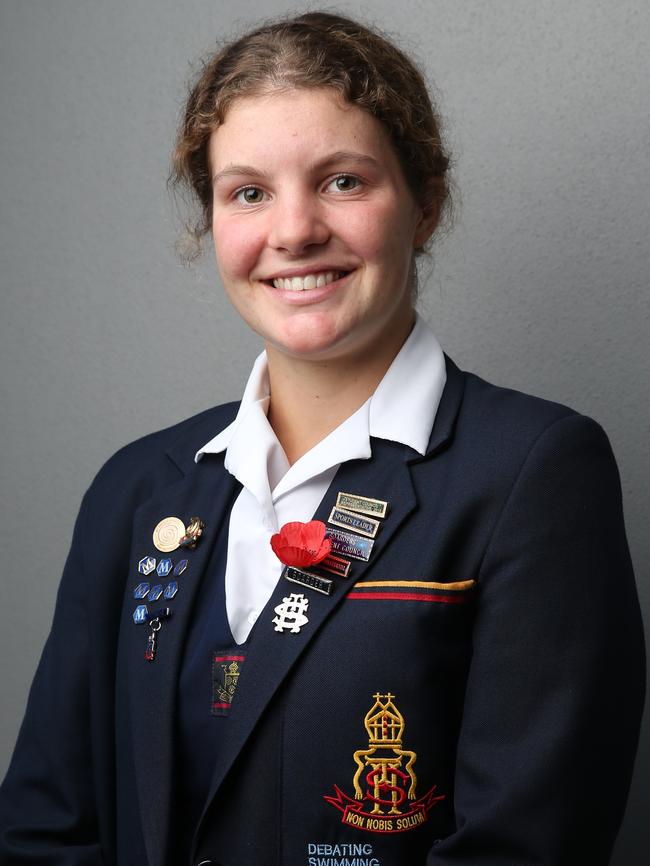Social media: What’s your teenager doing?
MANY dismissed it as the app used by people who liked the idea of their inappropriate selfies self-destructing. Now it’s the social medium of choice for 130 million users. Including your teen.

QLD News
Don't miss out on the headlines from QLD News. Followed categories will be added to My News.
FOR parents of teenage children, keeping track of their life on social media can be baffling, even when you write about technology for a living and you’re paid to keep track of the latest thing in social media.
“What do you want to know?” my 13-year-old daughter Meg asks during an ad break of MasterChef.
When parents talk about social media, they are typically talking about Facebook and Twitter, or

sites such as Flickr for photo sharing or Pinterest, which lets you “pin” items of interest. When teenagers talk about social media, it’s typically Instagram and Snapchat.
In the early days of Snapchat, many (including me) dismissed it as an app used by people who liked the idea of their inappropriate selfies self-destructing. Now it’s the social medium of choice for 130 million users a day.
In a recent Re/Code profile on Snapchat founder Evan Spiegel, the billionaire partner of Miranda Kerr, the writer summed up Snapchat as this: “Four years ago, teens used Snapchat for sexting. Last week, Barack Obama used it to plug healthcare reform”.
Social media is just one of those many things we progress through in life. In your teenage years, it’s all chat apps and funny photos. Later on you might sign up to Facebook to organise your social calendar. When you reach a certain age, it’s Pinterest for hobbies, and LinkedIn to find a job – and then you spend the rest of your life trying to work out how to escape the clutches of LinkedIn and those annoying notifications. Studies by market research firm GlobalWell Index show the relationship that Australian teenagers have with social media, with 94 per cent having a Facebook account, 60 per cent having an Instagram account and 65 per cent having a Snapchat account, making Australia one of Snapchat’s best performing markets. While that suggests almost every teenager is on Facebook, the “active user” stats tell a different story: 64 per cent of Australian teenagers are active on Facebook, 41 per cent are active on Instagram and 45 per cent are active on Snapchat.
Social researcher Mark McCrindle, who recently published a report into the use of social media by young Australians, says more than half of Australian teenagers and young adults have a Snapchat account compared with 1 in 7 of their parents.
“(Snapchat) is a place they can go that is their own platform, where their parents are less likely to be connected there,” McCrindle says. “They want to be able to connect and have their own space, which has always been what young people want.
“That’s why they developed slang. There are different ways of communicating in their code, creating an ‘in group’ which is them and an ‘out group’ which is their parents.
“Things are definitely life-stage-based. That is why Facebook has a challenge with young people at the moment because it has become the town square, the village green, and you’ve got a generation that doesn’t want to gather always with the crowd and their parents; they want to go elsewhere.
“We call this next generation not only the digital generation but also the visual generation. Snapchat and Instagram – they’re visual media even more than Facebook is and they communicate in that sense.

“It’s all short-form messaging and often a photo with a short little phrase can be a way of communicating what they’re up to, what’s going on, where they are, their thoughts or just a little bit of fun or interaction with their friends.
“It is a generation that lives in the moment. They don’t want to accumulate. They live in the now and it’s about the journey, not the destination. It’s a social interaction, an experience with friends in the real world lived in real time. The memories are in your head and that’s it. The words are spoken, are heard and that’s the end of it.
“It’s a generation that, in a sense, has taken normal dialogue, social interaction, that face-to-face connection, and put it into a digital form that’s not permanent.
“It’s then and there, and then it fades.”
Recently, US-based tech writer Nicole Lee wrote a column – “This thirtysomething finally figured out Snapchat”– talking about how even for someone familiar with social media, a new app might be obvious to a digital native but is confusing to the rest of us.
I know how Lee feels. I recently wrote a news story about a Snapchat misfire, when it released a filter that let people change their photos to look like Bob Marley. The filter was produced with the backing of the Marley estate but was accused of being “digital blackface”.
In order to report on it, I decided to Bob Marley myself. And then I spent 10 minutes of frustration trying to work out Snapchat filters before giving it up as a bad idea and seeking a lesson from my daughter that evening.
Once you learn how to use Snapchat filters that give you an animated tongue that rolls out of your mouth or a head like a koala, it’s fun for the whole family.
Although once it does become fun for the whole family it will perhaps be time for teens to turn elsewhere as their parents move into their patch.
I SAT DOWN WITH FIVE GIRLS FROM ST HILDA’S, an Anglican school at Southport on the Gold Coast where the students are encouraged to use technology. The school was one of the first in Australia, and the world, to adopt the iPad as a learning device and is recognised as an Apple Distinguished School for innovation, leadership and excellence. Like many schools, St Hilda’s has a social media presence, but its Instagram account is run by the students.
The students are aware of the pitfalls of social media. When asked if they use social media to make connections with strangers, rather than build the connections they already have in the real world, they quickly give reasons why that is not a good idea. But they’re also aware of the benefits social media has in managing their busy routines.
The three older girls, Lucy Coleman, 18, Alexandra Elliot, 17, and Courtney Withers, 16, who are in Year 12, can’t live without Facebook because it lets them organise their lives, from rowing training to school assemblies. The two younger girls, Maxine Moore and Kara Kroon, are both 14 and in Year 9, and see Facebook as something older people use, while Instagram is the way they organise things through group chats.

Some of the five use Facebook, all of them use Instagram and Snapchat and none of them uses Twitter.
“There’s no point to me joining Twitter,” Alexandra says. “None of my friends are on it, what am I going to be doing on it?”
Parents who feel they’re in touch with the younger generation because they tweet are in for some bad news.
“The only time I ever look at tweets is when it’s in a Buzzfeed post,” Courtney says. “They’ve compiled the tweets. I’m not actually having to go look at them or follow accounts. It’s just a compilation of the good tweets and the relevant information. That’s what Twitter feels like to me, irrelevant information. Millions of people sharing sentences.”
If social media companies want to know how to attract the younger generation, and Facebook has publicly talked about the challenge, they should listen to the way the girls talk about Snapchat. It’s fun. It’s silly. It’s inclusive. It’s informative. And, with the app providing information on your “streak” – which goals you have attained or how many consecutive days you have logged in – it’s habit-forming.
“I feel like the whole idea of Snapchat is somewhat pointless but somehow it works,” Alexandra says. “And people love it.”
Courtney says the fun of Snapchat becomes clear the more you use it, and the more your friends use it.
“Whereas Facebook, you could not check your account for months and then jump back on and see what people are up to. But Snapchat, often people would be having conversations through photos or things like that – it has to be something that you’re checking regularly and then you’re replying to people regularly.”
Kara, like many in her demographic, reads news through Snapchat. While social media is fun, she knows it’s also a tool to be used to express yourself with the future in mind.
“Maybe not at this age, but when I do start going out for employment,” Kara says.
“It can actually be a really great platform to showcase what you’re about and your values.”


